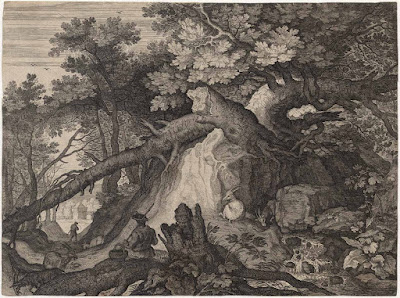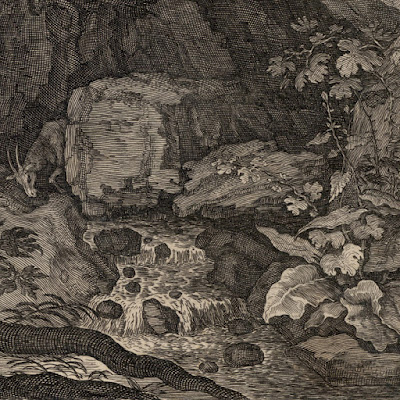Theodore Fourmois (1814–71)
“Près d'Ardenne”,
1850
Etching chine
collé trimmed near the platemark at the top and right sides.
Size: (sheet)
20.3 x 26.2 cm; (plate) 18.1 x 25.6 cm
Lettered below
the image borderline (lower right): "T. Fourmois"
Hippert &
Linnig 1874-9 I (Hippert, T & Linnig, J N, Le Peintre-Graveur Hollandais et
Belge du dix-neuvième siècle, 3 vols, Brussels, 1809)
The British
Museum offers the following description of this etching:
“Landscape of a
hill with rocks, a path in the centre descending from left to right, two
figures walking up along the path, a farmhouse in the centre with trees behind
it, a village in the right background; plate 23 of the catalogue 'Album de la
fête artistique à Bruxelles' (1850)”
(http://www.britishmuseum.org/research/collection_online/collection_object_details.aspx?objectId=3338423&partId=1&searchText=Landscape+in+the+Ardennes&page=1).
Condition:
marvellously crisp impression with printer’s creases/unevenness (?) in the chine
collé. The verso is lined with a fine washi support sheet. The sheet is in
excellent condition (i.e. there are no tears, holes, stains or foxing).
I am selling
this loosely drawn landscape for AU$78 in total (currently US$58.53/EUR52.56/GBP44.66
at the time of posting this listing) including postage and handling to anywhere
in the world.
If you are
interested in purchasing this landscape etching by a leading 19th
century Belgium printmaker, please contact me (oz_jim@printsandprinciples.com)
and I will send you a PayPal invoice to make the payment easy.
Fourmois is
best known for his landscapes of the Ardennes and Campine—although he did
venture into countryside of Dauphiné (south eastern France) and Switzerland. This
view of the rugged terrain for which the Ardennes is famous is captured
beautifully with Fourmois’ signature-style of building up an image with a layering
of tiny curved marks.
What I
especially like about this print is the way that Fourmois spotlights an almost
diamond-shaped area in the near foreground. For a moment, when I was gazing at
this spot-lit area, I had difficultly rationalising how he achieved this effect—as
if a shaft of light had illuminated the ground. But then I realised that the
artist has left a faint trace of plate tone (i.e. grey) over the plate and had
thoroughly wiped clean the plate tone from this particular area until it
gleamed.


















































